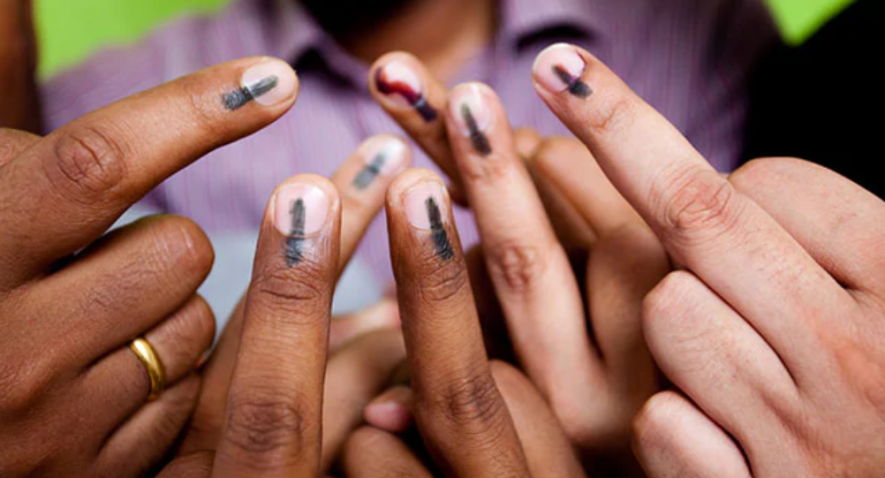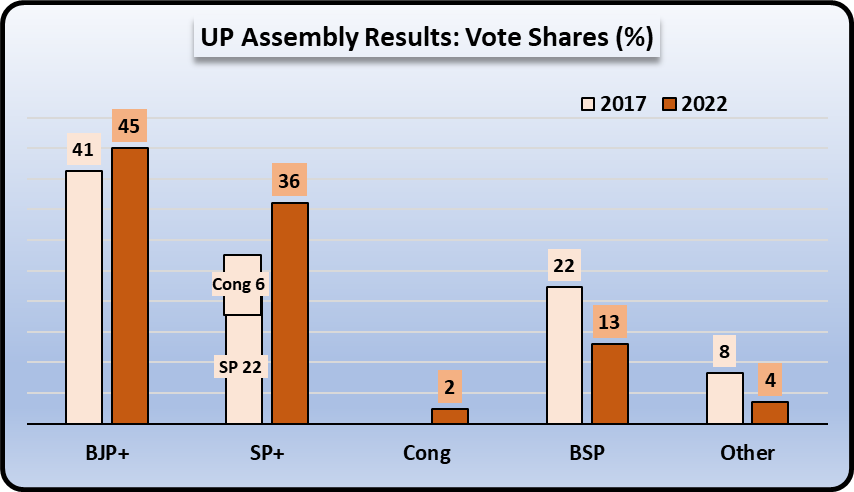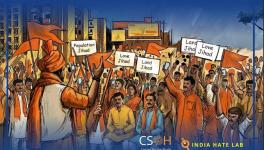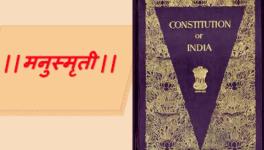UP Elections: Myths, Truths… and a Riddle

Usually after election results come out, there is a dismantling of myths created during the elections and creation of new myths. This happens in all elections but when a significant state like Uttar Pradesh is involved – it’s a feast of theories. Then, there are riddles for which everyone has a solution.
First, have a look at the chart below which gives vote shares of major political parties across 2017 and 2022, based on Election Commission data. As we all know by now, Bharatiya Janata Party’s (BJP) vote share ticked up from 41% to 45% (all figures are rounded off) while the Samajwadi Party (SP) alliance share climbed up from 28% to 36%. The alliance itself has changed – in 2017, SP was aligned with Congress, while in 2022, it was aligned with a bunch of sub-regional parties, including the Rashtriya Lok Dal (RLD).

Congress vote share declined further to a mere 2%, while Bahujan Samaj Party (BSP) plummeted from 22% last time to 13% this time. The share of ‘others’ and independents too declined. With this baseline, let’s turn to the topsy-turvy world of myths and truths.
Myth #1 - BJP won due to success of welfare schemes
Reality: This is the most popular theory, getting momentum from BJP itself, and from the mainstream media. Free foodgrain provided by the Central scheme to tide over the pandemic period, and additional items like cooking oil provided by chief minister Yogi Adityanath, to estimated 14 crore persons was key to this support. Houses for poor, cooking gas, schemes for girls and others also helped. Farmers were getting Rs.6,000 annual dole. A corollary to this is that these schemes ensured that women voters decisively supported BJP because of these schemes.
Undoubtedly, there is some truth in this but this is fraught logic. If people are voting only on issues related to economic assistance and relief, then high unemployment and sky-high prices of essential commodities would surely erode this goodwill. The COVID devastation, especially the high economic impact on poor families, would also take away from this positive feeling. Remember that for several decades, the state has not re-elected an incumbent party. It is a volatile and restless electorate.
Also, if this was the biggest reason then why would BJP lose over 50 seats from its last time’s tally? Why did BJP vote share go down in some of the poorest regions – in Bundelkhand’s 19 seats, its vote share plummeted from 46% in 2017 to 39% this time, in 40 seats of Southeast UP (Mirzapur, Sonabhadra, etc) its vote share went down from 39% to 34%, in Northeast UP (Kushinagar, Maharajganj, Ballia and the eastern Terai of Shravasti etc.) it rose marginally from 38.6%
to 39.9%, although BJP seats went down from 63 to 49, out of 82 in this belt?
If welfare schemes were winning the election, BJP would have swept these regions of extreme poverty. So – it is not these schemes alone that won the election for BJP. There is something more.
Myth #2 – Everybody has become communal
Reality: This is a theory popular among certain well-meaning sections who struggle to explain the BJP’s victory. Again, there is some truth in this but it is a gross exaggeration to say that Hindutva alone led to this victory. First, some data. Although BJP got about 46% of votes polled, if one calculates their share of votes in the total electorate, it is just about 27%. That’s because a large chunk of people – nearly 40% - did not vote at all. So, BJP supporters cannot be, by any stretch, thought to be in a majority in this vast state with 15 crore voters and 24 crore population.
But, aside from this, it has to be noted that five years of BJP rule led by Yogi Adityanath has indeed established a considerable dominance of the Hindutva discourse. This is reflected in the marginalisation of the Muslim community, their stigmatisation and the complementary feeling of Hindu superiority among large sections of people. This, in turn, has created a bond with the vehicle of this Hindutva, namely, BJP.
The celebration of the Ram Temple building, the claimed renovation of 700 temples, the building of Kashi-Vishwanath corridor in Varanasi, the renaming of places, and most of all, the continuous RSS/BJP propaganda against Muslims, insidiously carried out on every occasion has been a conscious path chosen by BJP under Yogi, and it has indeed created a support base.
Yet, the BJP ended up with 46% of votes polled with the remaining going to Opposition parties. The farmers’ movement, the atrocities on dalits, unemployment, price rise, false promises on doubling farmers’ income etc. all cut away from the Hindutva vote bank. There should be no doubt that communal poison has been widely sown in the state and it is gravely threatening the very foundations of the republic. But this election is not the end, it’s not the victory of Hindu Rashtra.
Myth #3 – The Opposition did its best yet it lost
Reality: The Opposition – operatively this means the SP alliance – carried out a strenuous election campaign. Reportedly, SP leader Akhilesh Yadav addressed 131 rallies in all. But it would be a mistake to imagine that this was all the Opposition could do.
The biggest handicap or weakness of the Opposition was that it practically started its work just two-three months before the elections. For the past five years, and especially after the resounding defeat of the SP-BSP combine in the 2019 general elections, the Opposition had become dormant. Although Priyanka Gandhi-led Congress was active in its own way but their roots in the people are so flimsy now that these only had some celebrity-like value and no political support.
The SP and BSP were both largely absent from the ground during the pandemic period. The lakhs of returning migrants, corpses floating in river Ganga, the desperation for oxygen cylinders, the collapsed healthcare system – in all these crises these parties provided no support, they fought for nobody. Or, perhaps, they were insignificant in their presence. Earlier, when the Yogi government launched an offensive against Muslims and other secular people for protesting against the citizenship law, these parties did practically nothing.
Even in the election rallies, Akhilesh Yadav looked like he was taking for granted that people would support him and his party, the SP. In fact, he repeatedly asserted that he was not fighting the election but the people were fighting it. He never attacked the BJP/RSS (Rashtriya Swayamsevak Sangh) for its communal and poison-spreading role, he didn’t persuade the people on the anti-people policies of PM Narendra Modi and CM Yogi. It was just rhetoric. The same would have been done by his activists and supporters. This could never have been a match for BJP’s organisation and support base.
Myth #4 – Dalits Didn’t Support SP+
Reality: Seat-wise there is no data to show this, although analysts say that one section of dalits remained with BJP like earlier, while BSP’s 12% vote share is mainly from the jatav community, the biggest dalit community in UP. However, there is another indicator: the results of 84 seats reserved for Scheduled Castes and two reserved for Scheduled Tribes. In 2017, BJP had got nearly 42% votes in these 86 seats and won 73 of them. The SP had got 23% vote share while BSP got 24%. This time round, BJP vote share dipped slightly to 39% but it lost 21 seats, settling down at 52. SP vote share increased to 30% and its seats went up from 10 to 23. BSP vote share declined to 14%. Clearly, a big section of dalits deserted BJP and shifted to SP, if the reserved seats electorate is taken as a proxy for their voting.
Riddle – How much money did BJP spend?
Besides PM Modi announcing over Rs.1 lakh crore worth of projects before the elections were announced, the BJP must have spent an enormous but unknown amount of money in these elections.
E-shram relief was given to workers as was the instalment of PM Kisan. Advertising (digital, outdoor, electronic and print media) continued relentlessly through the past four months, or from even before that. A whole platoon of leaders crisscrossed the state, with PM Modi, Home Minister Amit Shah, BJP President JP Nadda, Defence Minister Rajnath Singh and many others addressing dozens of rallies, hopping around in helicopters. There are unconfirmed claims that money flowed like water at the village level. Opposition could no way match this juggernaut. How much money was spent by each? Nobody knows.
Get the latest reports & analysis with people's perspective on Protests, movements & deep analytical videos, discussions of the current affairs in your Telegram app. Subscribe to NewsClick's Telegram channel & get Real-Time updates on stories, as they get published on our website.
























